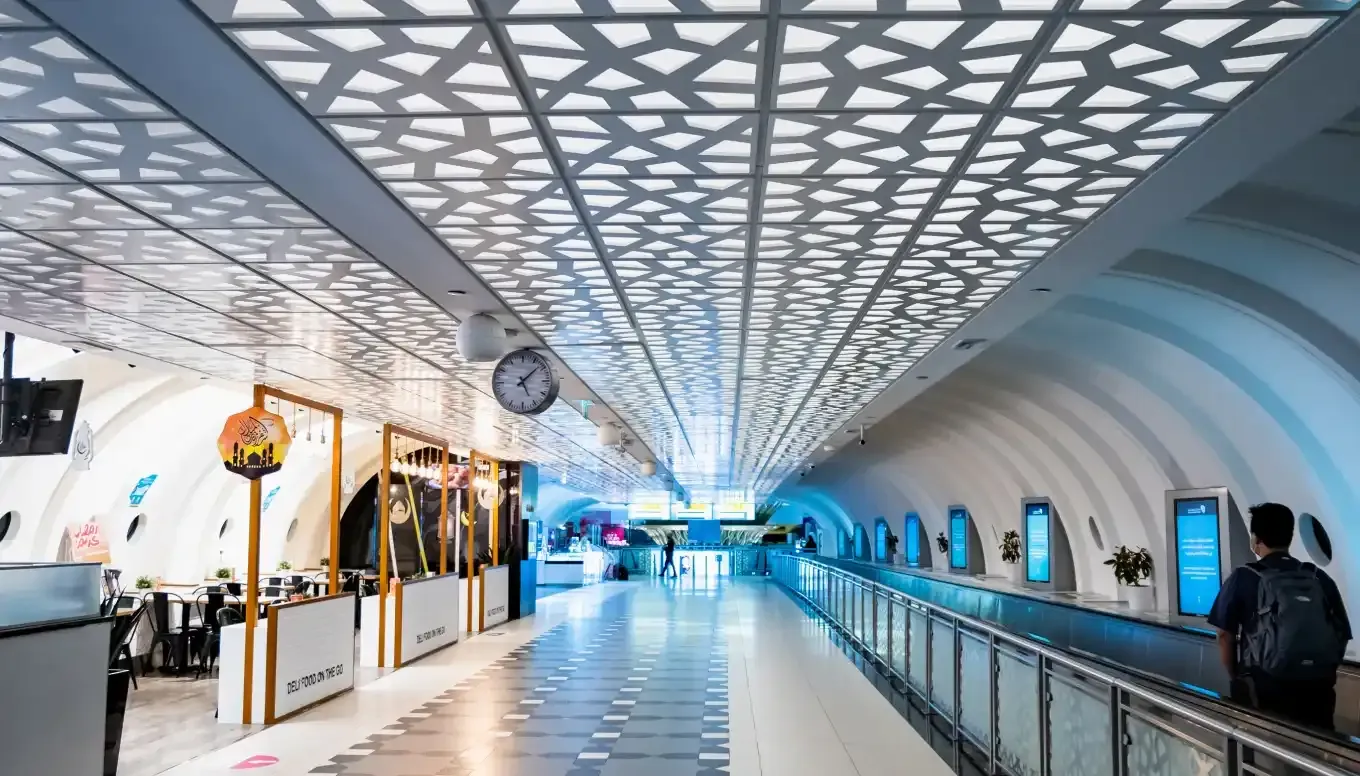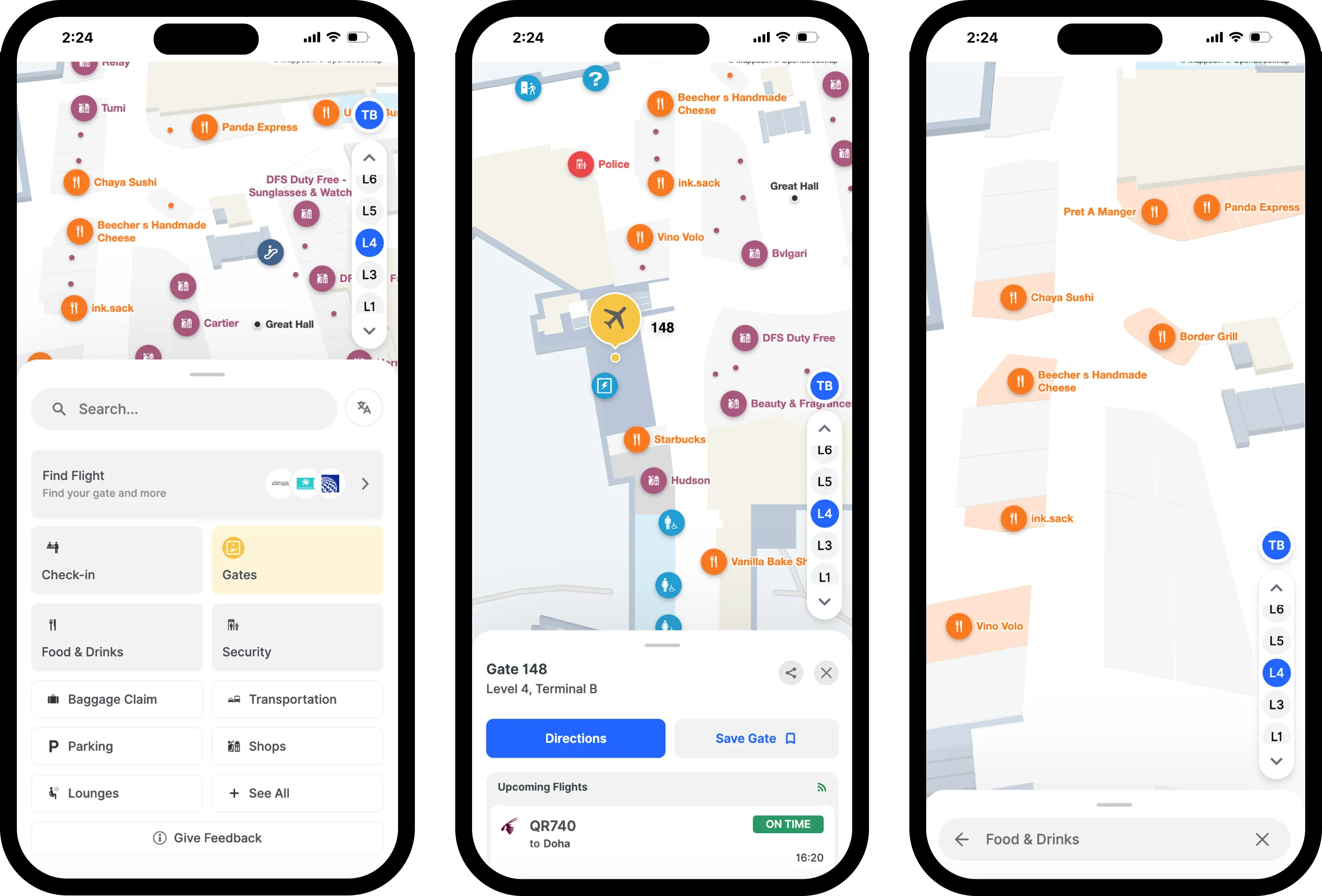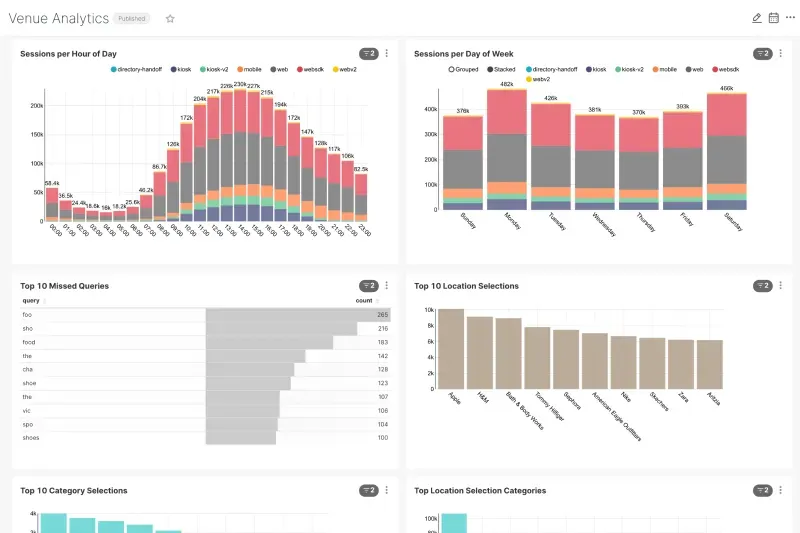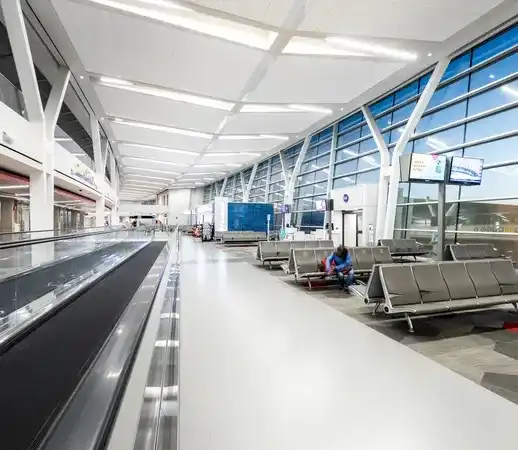Start Here
Airport operations management encompasses the coordination of landside operations, airside operations, finance and billing, and information management, all aimed at providing passengers with a stress-free travel experience while maintaining industry standards. Indoor mapping technology has become a key tool for improvement by streamlining staff tasks through real-time data, optimizing resource allocation for gates and equipment, facilitating proactive facilities management, and enhancing safety through emergency preparedness and security checkpoint monitoring.
Have you ever wondered how airports ensure a seamless and stress-free travel experience? In this article, we’ll take a closer look at airport operations—their inner workings, their mission to make passenger journeys as smooth as possible, and the pivotal role of airport operations software including flight information display systems, digital signage and indoor maps in enhancing every aspect of these operations.
What are airport operations?
Airport operations encompass the day-to-day activities that keep an airport running smoothly, all while upholding the highest industry standards. A dedicated team of employees ensures that everything, from baggage handling to security checks to flight scheduling, operates seamlessly. These operations are all aimed at one overarching goal: to provide passengers with a stress-free and efficient travel experience.

Why is airport operations management important?
Airport operations management is the backbone of a smoothly functioning airport. It's essential because it ensures that passengers can move through the airport with ease, flights remain on schedule, and security measures are maintained. Without effective operations management, the airport experience could be chaotic and unpredictable, emphasizing the importance of providing excellent customer service and implementing best practices for the satisfaction of all customers.
Types of airport operations
Landside operations
Landside operations focus on everything that happens outside of the airport terminals. This includes parking facilities, road access, passenger drop-off zones, and ground transportation services. Efficient landside operations are essential to minimize traffic congestion, provide convenient parking options, and ensure passengers can easily access the terminal buildings.
Airside operations
Airside operations, on the other hand, deal with activities within the restricted areas of an airport. These encompass tasks related to aircraft, runways, taxiways, and all aspects of air travel. For instance, ensuring that departures and arrivals of planes occur safely and on schedule is a primary objective of airside operations.
Finance
The financial aspects of an airport are equally critical. This includes managing budgets, invoicing airlines for services, and handling revenue from various sources like parking fees and concessions. Accurate financial management is essential for controlling costs and ensuring efficiency, allowing for necessary improvements and expansions to meet the evolving needs of the industry.
Information management
Information management involves handling a vast amount of data related to flight schedules, passenger information, and resource allocation. Effective data management ensures that airport staff can make informed decisions, which in turn, streamlines their processes and leads to better service for passengers and airlines.
Security
Security is an essential aspect of airport operations, focused on maintaining the safety of passengers, staff, and infrastructure. Security teams are responsible for monitoring passengers and luggage, conducting security checks, and responding swiftly to potential threats or emergencies. Their efforts keep the airport environment secure, support regulatory compliance, and help maintain smooth airport operations by minimizing disruptions and instilling confidence in both travelers and stakeholders alike.
Facilities management
Facilities management teams are responsible for maintaining the airport’s physical infrastructure, including terminals, runways, parking lots, and all passenger amenities. These teams make sure that all facilities are clean, safe, and fully operational, minimizing disruptions and creating a comfortable environment for travelers and staff. Effective facilities management is crucial for operational efficiency, regulatory compliance, and delivering a positive first impression to millions of passengers each year
Passenger experience
The passenger experience team focuses on every aspect of a traveler’s journey, from arrival and check-in to navigating the terminal and accessing amenities. Their goal is to provide a seamless, stress-free, and enjoyable experience by offering clear wayfinding, helpful staff, and responsive services. A strong passenger experience not only boosts customer satisfaction and loyalty but also drives non-aeronautical revenue by encouraging passengers to spend more time—and money—within the airport.

Key systems for modern airports
Modern airport operations rely on a suite of advanced technological systems and software to ensure efficiency, safety, and a seamless passenger experience. From real-time flight information and digital signage to integrated management platforms, these tools are essential for managing complex airport environments.
Trusted by the world's top airports including LAX, Keflavik, YYC Calgary International, Schiphol, and Pittsburgh International, Mappedin is a leading provider for airport venue operations, providing indoor mapping that supports parking, passenger wayfinding, and security, as well as powering digital directories and airport signage to optimize both operations and non-aeronautical revenue streams.
– Sigurour Petur Oddsson, Commercial & Airport Development, Keflavík Airport
Flight Information Display System (FDIS)
A Flight Information Display System (FIDS) is central to airport operations, providing real-time updates on arrivals, departures, gate assignments, and delays. Digital signage and mapping solutions with integrated FIDS ensures passengers and staff have access to the latest flight information across terminals, ultimately reducing confusion and supporting smooth passenger flow.
When connected with indoor mapping and digital signage, FIDS can trigger dynamic wayfinding, instantly rerouting travelers to new gates or alerting them to schedule changes.
Airport digital signage
Airport digital signage delivers live information, directions, and promotional content through interactive kiosks, video walls, and digital directories. These systems enhance the passenger journey by offering intuitive navigation, real-time alerts, and targeted advertising that can drive non-aeronautical revenue.
Mappedin’s digital signage solutions allow airports to update content instantly, promote retail offers, and provide accessible wayfinding for all travelers.

Airport wayfinding system
Airport passengers are typically a bit stressed. Add in missing baggage, flight delays and confusing static maps, and airports risk losing a customer forever. Enter indoor maps. Interactive 3D maps offer a multifaceted approach to enhance airport operations, addressing key concerns like:
Streamlining staff tasks
In the bustling environment of an airport, efficient staff task management is crucial. Indoor maps, with their real-time data capabilities, empower airport personnel to streamline passenger flow, optimize baggage handling, and coordinate security checks. This translates to smoother task management, which directly improves the overall passenger experience.
Efficient resource allocation
Allocation of airport resources, including gates, baggage carousels, and equipment, can be a logistical puzzle. Indoor maps provide a visual representation of real-time data, enabling airport authorities to make informed decisions on resource allocation. Additionally, indoor maps enhance navigation for employees, helping them easily locate and manage resources, which in turn contributes to smoother and more efficient airport operations.

Airport facilities management
Maintaining airport facilities is paramount to ensuring a positive passenger experience. Indoor maps come into play here by allowing real-time tracking of facility status and infrastructure. This proactive approach facilitates maintenance and repairs, ensuring that all facilities remain operational and in top condition.
Enhancing airport safety and security
Indoor maps also contribute significantly to enhancing safety and security for both passengers and airport operators. They aid in emergency preparedness by providing a visual layout of the airport, which is crucial during safety inspections and real emergencies. Additionally, real-time data can be used to monitor security checkpoints and respond promptly to potential threats, ultimately making airports safer for everyone.
Airport management software
An airport management system is the backbone of airport operations, integrating data from multiple sources to streamline workflows, resource allocation, and communications. These platforms centralize control over everything from gate assignments and maintenance schedules to passenger analytics and compliance reporting.
Mappedin’s platform integrates seamlessly with airport management software, providing real-time indoor maps and analytics to optimize operations and enhance decision-making.
Airport parking software
Airport parking software simplifies the management of parking facilities, enabling real-time tracking of space availability, digital payments, and seamless integration with indoor maps. By guiding travelers to optimal parking spots and providing up-to-date occupancy data, these systems reduce congestion and improve the overall passenger experience.
Mappedin for Airports gives teams and passengers the information they need to get to where they're going—from flight info to security waits to parking and shuttle times. Content updates in real time, giving passengers current information wherever they look.
Airport security software
Airport security software is vital for monitoring passenger flows, managing access control, and responding to emergencies. These systems provide real-time surveillance, automate security checks, and integrate with indoor maps to ensure rapid response and efficient coverage of all airport zones.
Mappedin’s indoor mapping software for airports supports security operations by visualizing checkpoints, restricted areas, and emergency routes, helping teams maintain a safe and compliant environment.
Frequently asked questions about airport operations
What are airport operations?
Airport operations encompass the day-to-day activities required to keep an airport running smoothly and safely. This includes managing landside and airside logistics, finance, information systems, security, and passenger services—all aimed at providing an efficient and stress-free travel experience for passengers and airlines alike.
What is FIDS?
A Flight Information Display System (FIDS) is a digital system that displays real-time flight data such as arrivals, departures, gate assignments, and delays throughout the airport. FIDS helps passengers and staff stay informed and enables seamless navigation by integrating with wayfinding signage and digital directories.
How does airport digital signage work?
Airport digital signage uses electronic displays, kiosks, and video walls to present live information, directions, and promotional content to travelers. These systems are managed centrally, can be updated in real time, and often integrate with indoor maps and FIDS to provide dynamic wayfinding, alerts, and targeted advertising that enhance both passenger experience and airport revenue.
How do airports increase non-aeronautical revenue?
Airports increase non-aeronautical revenue by offering and optimizing services such as retail shopping, dining, advertising, parking, car rentals, and real estate leasing. Digital tools like indoor mapping, targeted digital signage, and loyalty programs help drive passenger engagement, streamline navigation, and promote ancillary services, leading to higher spending and diversified income streams.
What is airport management software?
Airport management software is a centralized digital platform that integrates and streamlines various airport operations, including resource allocation, flight scheduling, facility management, and passenger analytics. These systems improve operational efficiency, enhance decision-making, and support seamless communication across airport teams and third-party vendors.
What are airport operations jobs?
Airport operations is a massive undertaking, which takes the teamwork of multiple roles and departments to do it successfully. Some airport operations jobs include:
- Airport Information Specialists are the go-to source of information for passengers. They assist travelers with queries about flights, facilities, and services. Their role is pivotal in ensuring that passengers have a positive experience while navigating the airport.
- Airport Operations Officers are responsible for coordinating activities on the ground, ensuring that everything runs smoothly. They oversee tasks like aircraft turnaround, gate assignments, and baggage handling, making sure that flights operate on schedule.
- Airport Security Officers play a critical role in maintaining the safety and security of the airport. They monitor passengers and luggage, conduct security checks, and respond to potential threats or emergencies, ensuring a secure environment for all.
- Air Traffic Controllers are responsible for managing the flow of aircraft in the air and on the tarmac around the airport. They ensure safe takeoffs, landings, and efficient routing, helping to prevent delays and accidents.
What is passenger experience in an airport?
Passenger experience in an airport refers to the overall satisfaction and ease of travel encountered during a traveler’s journey. It encompasses everything from check-in and security procedures to the availability of amenities and services within an airport. A positive customer experience is crucial for ensuring repeat business.
Why is passenger experience important in airports?
Passenger experience is vital because it directly impacts an airport's reputation and success. A pleasant and stress-free journey encourages passengers to return, use the airport's facilities, and recommend it to others. Good passenger experiences can lead to increased revenue and growth for the airport.
What makes a good airport experience?
A good airport experience involves several factors, including efficient check-in and security procedures, a wide range of dining and shopping options, clean and comfortable facilities, clear signage, and helpful staff. It's about making the journey as smooth and enjoyable as possible, leaving travelers with a positive impression of the airport.
Interested in seeing how Mappedin for Airports works? Contact us today to get a personalized demo.
Share


